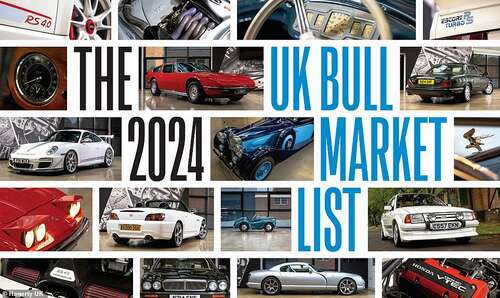Ever considered a classic car as an investment? Given some collectible models can reap bigger financial returns than art, property, fine wine and jewellery, it’s a thought that has likely crossed the minds of many petrolheads… though the fear of choosing the wrong car has turned them off.
But what if you had expert insight into which vehicles are likely to see a gain in the coming months and years?
That’s exactly what Hagerty UK’s Bull Market Report aims to do – a data-crunching exercise to earmark motors from the past that are ripe for appreciation, beginning this year.
Below are its top picks for 2024, with the cheapest of the models available today for less than £2,000.

The classic and collectible cars earmarked to rise in value in 2024: Hagerty has released its Bull Market Report, which identifies motors that are ripe for an increase in price in the next 12 months. Here are the recommendations for this year
The Bull Market report is compiled by Hagerty UK’s team of classic car boffins who annually pull together a list of motors they believe are solid four-wheeled future gainers from 2024.
Its global data analysts spend months identifying cars which offer the best mix of great ownership experience and financial reward by tapping into unrivalled market data on private and auction sales results as well as fluctuations in insurance premiums.
The results are then further examined to find indicators that suggest a car is rising in value and is increasingly in demand amongst car enthusiasts.
Note that while the Hagerty Bull Market is aimed at people who want to find, buy, and drive a classic or modern classic vehicle, the recommendation is to always choose a car the buyer likes first and foremost. If the car later delivers a healthy return financially, that should be considered as an added bonus.
The selection of cars in the 2024 Hagerty Bull Market is as wide and diverse as ever, meaning there should be a car to suit most tastes and budgets.
John Mayhead, editor of the UK Hagerty Price Guide, said: ‘The Bull Market is a highlight of my year. Working with our Hagerty analysts around the world to identify what we forecast will rise in value and is interesting and fun to own is really rewarding.
‘This year’s UK Bull Market list is the most eclectic ever, and I think it reflects the diversity of the classic and collector market here in the UK.’
Here’s the eight cars it has recommended for 2024…
1. Alvis Speed 20 & 25 (1932–1940)
Average value today: £52,000–£99,400

The Alvis Speed 20 and 25 were cars that prioritised strong performance and confidence-inspiring handling in their heyday. Today, they look good value against rivals from the same era

Coventry-based Alvis made 1,165 Speed 20s between 1932 and 1936 and fewer than 200 Speed 25s from 1937 to 1940. That makes these cars incredibly rare today

Hagerty Price Guide average values of all Alvis models have risen from £43,077 to £56,867 in the past 12 months, a climb of almost a third (32%)
Wind the clock back some 90 years and the Alvis Speed 20 and 25 were cars that prioritised strong performance and confidence-inspiring handling in their heyday.
And it is these qualities that today elevate them above more rudimentary alternatives from the era, and – importantly in terms of investment – without the price tag of equivalents with more exotic nameplates.
Coventry-based Alvis made 1,165 Speed 20s between 1932 and 1936, across SA, SB, SC, and SD updates, and fewer than 200 Speed 25s from 1937 to 1940.
Typical of the period, the models were built in several body styles, including two and four-door sports saloons plus a drophead coupe in the 20, and as a four-door sports saloon for the 25. Various coachbuilders also rebodied them in racier formats, such as open two-seaters, meaning many that remain today are totally unique.
All Speed 20s used straight-six engines with a four-bearing crank and overhead valves, and were brisk, too, with 75mph easily attained and 83mph flat out. Speed 20s and Speed 25s cannot be considered cheap cars, but they were quality items in-period and represent excellent value today.
Hagerty’s expert team says: ‘Despite the lack of brand recognition, Hagerty Price Guide average values of all Alvis models have risen from £43,077 to £56,867 in the past 12 months, a climb of 32 per cent.’
2. Austin J40 (1949–1971)
Average value today: £1,500–£10,800

Pedal power: Another ‘vehicle’ identified by Hagerty UK for a rise in value in 2024 is the post-war Austin J40 pedal car

Production started in 1949 and continued all the way until 1971. If you were a young child in the 1950s or ’60s, there’s a fair chance you drove one at some point, with more than 30,000 produced

A good one ripe for restoration is around £4,000, and the J40’s predecessor, the Pathfinder, can be even more valuable
From six-cylinder grunt to two-legged performance – the next ‘vehicle’ identified for a rise in value in 2024 is the post-war Austin J40 pedal car.
Production started in 1949 and continued all the way until 1971.
If you were a young child in the 1950s or ’60s, there’s a fair chance you drove one at some point, with more than 30,000 produced – 32,098, to be precise. Out of production now for more than half a century, survivors are relatively rare.
That attrition, plus growing demand, means prices are about what you’d expect from the A-series–powered A40 mentioned above, with rundown projects available for around £1,500 rising to £10,000 for one in museum-ready condition.
A good one ripe for restoration is around £4,000, and the J40’s predecessor, the Pathfinder, can be even more valuable.
Hagerty says: ‘Although values have increased significantly over the last few years, demand still massively outstrips supply.’
3. Daimler Six (1994–1997)
Average value today: £1,600–£12,500

You can get your hands on a ‘fair’ condition example of the Daimler Six for as little as £1,600 today. And Hagerty believes it is one that’s surely going to go up in price soon

Hagerty says it makes the list as ‘an almost ridiculously cheap car which offers a huge amount of motoring for the money’

With many being scrapped each year, they are becoming ever rarer. With the earliest cars now 30 years old, they are quickly moving toward the zone of being a true classic.’
The X300-generation XJ and Daimler Six are cars that don’t need an endowment to afford today, which is ironic as the Jaguar XJ and its ilk still have more than a whiff of ‘old money’ about them.
In the right condition and colour, there’s definitely something of the family heirloom about this particular piece of automotive history.
The X300 was very well regarded when new, despite a few flaws inherited from its XJ40 predecessor. Styling was a marked improvement, evoking the original XJ6 and banishing the XJ40’s boxiness, and while Jaguar did sacrifice passenger space for style, interior quality took a step upwards.
Hagerty says it makes the list as ‘an almost ridiculously cheap car which offers a huge amount of motoring for the money’.
The experts added: ‘With even the best examples in the world, in concours condition with superb spec, being worth just over £10,000 and driving examples available for under £2,000, this is a practical, stylish car.
‘Plus, with many being scrapped each year, they are becoming ever rarer. With the earliest cars now 30 years old, they are quickly moving toward the zone of being a true classic.’
4. Ford Escort RS Turbo (1985–1991)
Average value today: £8,200–£35,800

Given the recent dramatic spike in eighties and nineties Fast Ford values, the Escort RS Turbo’s inclusion in a list of this kind shouldn’t come as a huge surprise…

A VW Golf GTI might be better built or a Peugeot 205 GTI more engaging to drive, but both have already dramatically increased in value. Hagerty says the RS Turbo looks and feels more exotic – and is more of a dark horse

An RS Turbo will still stand out today, even amongst other popular Fords of the era like the XR3i and Mk3 Capri, with its deep bodykit, distinctive wheels, spotlights, and well-bolstered Recaro racing seats (pictured)
Given the recent dramatic spike in eighties and nineties Fast Ford values, the Escort RS Turbo’s inclusion in this list shouldn’t come as a huge surprise.
While may not rank near the top on the list of the best-handling hot hatchbacks, it has become an aspirational version of a car you’d once seen by the hundreds on the roads every day.
There’s no doubt an RS Turbo still stands out today, even amongst other popular Fords of the era like the XR3i and Mk3 Capri, with its deep bodykit, distinctive wheels, spotlights, and well-bolstered Recaro racing seats.
A VW Golf GTI might be better built or a Peugeot 205 GTI more engaging to drive, but both have already dramatically increased in value beyond the affordability of many petrolheads.
And Hagerty says the RS Turbo looks and feels more exotic, and despite a few high-profile sales, it is more of a dark horse.
Average values have grown in recent times on the back of Princess Diana’s RS Turbo selling in August 2022 for a scarcely-believable £687,500. Yet, Hagerty says that since then the average value of a pristine example of the performance Escort has increased only steadily to £35,800.
‘Whilst everybody accepts that Diana’s car was a one-off, it undoubtedly drew attention to a model that hadn’t gained as much of the limelight as some of its other fast Ford stablemates,’ the classic car valuations team said.
‘Hagerty’s average values for all Ford RS and Cosworth models have risen from £29,886 to £42,225 over the past five years.’
5. Honda S2000 (1999–2010)
Average value today: £11,500–£22,000

The Honda S2000 was one of the most well-regarded two-seat roadsters on the market around the Millennium. Having not earned legendary status initially, they are now growing in value, Hagerty says

Later, post-facelift, S2000s from 2004 onwards have gained 20% in value in the last two years, the classic car market experts claim

Hagerty recommends keeping an eye out for signs of hard use when searching for one today and warns they are now becoming susceptible to corrosion
Cast your memory back to the Millennium and the affordable roadster market and the S2000 should be one of the two-seat sports cars that quickly springs to mind.
While it doesn’t quite have the legendary status of Japanese performance machines of the 1990s and 2000s to match the Honda NSX and Nissan Skyline GT-R, the S2000 certainly retains a cult following.
Having arrived in Britain in 1999, it was typically Honda in its execution. At its heart is a high-revving 2.0-litre four-cylinder petrol engine, driving the rear wheels through a six-speed manual gearbox.
The post-facelift cars from 2004 onwards have gained 20 per cent in value in the last two years.
Hagerty recommends keeping an eye out for signs of hard use when searching for one today and warns they are now becoming susceptible to corrosion.
The Hagerty Valuation Team describes the S2000 as a ‘demographic pick’, adding: ‘It has really hit Hagerty’s radar this year, with the number of policies added globally in 2023 already 17 per cent higher than last year, a rate five times that of all vehicles.
‘It’s a car that really appeals to younger drivers: 59 percent of policyholders are aged 49 and under, with 17 per cent under age 30.’
6. Maserati Indy (1969–1975)
Average value today: £39,000–£69,000

The Indy was built to celebrate Maserati’s two victories at the Indy 500, albeit somewhat late as Maserati won the famous race in 1939 and 1940

Hagerty’s Valuation Team says it is on the list not because it has gone up in value in recent months but because prices have dropped – and now means this is a car that offers great value for money

Maserati built 1,104 cars in total, so there isn’t an abundance of them up for grabs
The Maserati Indy is another car picked out by Hagerty’s experts because it represents great value for a car of its style, driving qualities, and heritage.
The Indy styling was the work of Vignale, and the name celebrates Maserati’s two victories at the Indy 500, albeit somewhat late as Maserati won the famous race in 1939 and 1940.
Power initially came from a 256bhp, 4.2-litre, 90-degree, quad-cam V8, with capacity expanded in 1970 to 4.7 litres (with 286bhp) and again in 1972 to 4.9 litres (with 316bhp).
Maserati built 1,104 cars in total, so there isn’t an abundance of them up for grabs.
Hagerty’s Valuation Team says it is on the list not because it has gone up in value in recent months but because prices have dropped – and now means this is a car that offers great value for money.
‘Just prior to the pandemic, Hagerty’s average value [for cars in excellent condition] peaked at over £80,000 for the 4.9-litre model, but that has dropped back to £69,200, a value last seen in 2016,’ the team added.
7. Porsche 911 (997.2) GT3 RS 4.0 (2011)
Average value today: £290,000–£560,000

The 997.2 GT3 is often deemed one of the greatest Porsche 911s of all time – and therefore, one of the greatest driver’s cars of all time

What makes it more collectible is the notable inclusion of a manual gearbox, rather than a PDK dual-clutch auto. The GT3 RS 4.0 is rare too, as Porsche made only 600 during the 2011 production run

Around seven in 10 insurance quotes on the 911 comes from people aged 50-plus, Hagerty says
What makes it more collectible is the notable inclusion of a manual gearbox, rather than a PDK dual-clutch auto. The GT3 RS 4.0 is rare too, as Porsche made only 600 during the 2011 production run
For those with deeper pockets and looking to invest in a serious performance car of the recent era, the Porsche 997 GT3 RS 4.0 is a motor that needs no introduction but is also ripe for a jump in value in the coming months and years.
It’s often deemed one of the greatest 911s of all time – and therefore, one of the greatest driver’s cars of all time.
Its power figures still sound healthy today, if not quite as barmy as some modern performance cars: 493bhp and 339lb ft of torque is enough to roar to 62mph in under four seconds and onto speeds of up to 193mph.
What makes it more collectible is the notable inclusion of a manual gearbox, rather than a PDK dual-clutch auto. The GT3 RS 4.0 is rare too, as Porsche made only 600 during the 2011 production run.
‘These cars are remarkably stout in their own right, for something so focused, and could very well be peak 911,’ says Hagerty.
‘The 997 GT3 RS was only added to the UK Hagerty Price Guide in 2022, so price trend data is still young, but the model has many of the characteristics that Hagerty believes mark out a collectable, from its last-of-the-line engine to its analogue driving feel.
‘Nearly 70 per cent of Hagerty’s [insurance] quotes comes from people aged 50-plus, but Porsches transcend generations, and demand consistently surpasses availability.’
8. TVR Cerbera (1996–2003)
Average value today: £27,100–£41,200

A risky return? TVR’s of the late nineties don’t have the best reputation for reliability. But Hagerty still believes the Cerbera is a sound investment

‘A Cerbera still represents good value for the performance and design on offer, with the most affordable models only new MX-5 money and the very best on the market a good chunk less than a Boxster,’ Hagerty says

Buyers are urged to find a car in the hands of an owner who has a deep-served knowledge of the brand, as they will be well aware of – and rectified – many of the common problems with TVR cars of this generation
Launched in 1996, the Cerbera still looks spectacular today. While it’s not aggressive – like a modern performance car – it is low-slung and muscular, with a cabin that feels like a cross between something by Salvador Dali and the work of generative design.
Hagerty’s top tip is to buy the best Cerbera you can afford, as there’s no such thing as a cheap TVR, and lower-priced examples will almost certainly need the most work from the get-go. Find an owner who has a deep-served knowledge of the brand too, as they will be well aware of – and rectified – many of the common problems with TVR cars of this generation.
The high-power Red Rose versions (440bhp from TVR’s own 4.5-litre, 75-degree V8, compared to 350bhp from the in-house Speed Six) are the ones to have if your budget can stretch, while the ‘Cascade’ flip paints are also more desirable now than they were new.
TVRs have a scary image but they’re far better to drive than you might expect, and the Cerbera is from the same breed.
‘A Cerbera still represents good value for the performance and design on offer, with the most affordable models only new MX-5 money and the very best on the market a good chunk less than a Boxster,’ Hagerty says.
‘It’s another model that Hagerty sees as being good value, and after several years of flat prices, average values have started to creep up, increasing nearly 3 per cent in the past 18 months, from £25,513 to £26,181.
‘Top-of-the-range Red Rose models have increased even more, with the best having recently surpassed the £40,000 barrier. That’s still not a lot of money for an extraordinary British sports car, one that turns heads and has such an analogue driving experience.’
Some links in this article may be affiliate links. If you click on them we may earn a small commission. That helps us fund This Is Money, and keep it free to use. We do not write articles to promote products. We do not allow any commercial relationship to affect our editorial independence.











